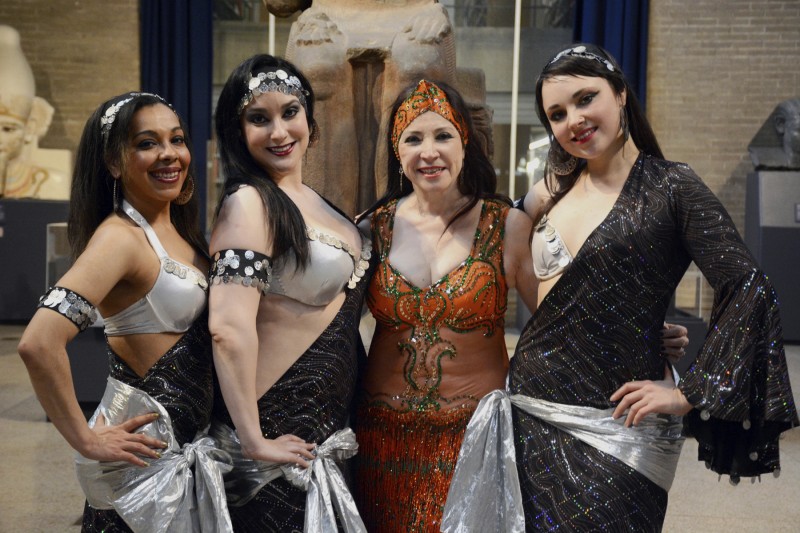Egyptomania! at the Penn Museum: March 24

Mummies and pyramids. Magic wands. Heart scarabs. Hieroglyphs and papyrus paper. Canopic jars and Shabti figurines.
The Penn Museum will spotlight all things Egyptian on Saturday, March 24, 11 a.m.-4 p.m., for Egyptomania! The family-friendly day, set in and around the Museum’s world-renowned ancient Egyptian galleries, features a mummification workshop, ancient Egyptian hieroglyph classes, belly dancing, a talk by an Egyptian archaeologist, storytelling, craft making and a scavenger hunt.
Spotlight on the Sphinx
Big changes are coming to the Penn Museum in the months and years ahead, and Egyptomania! provides a special occasion for guests to visit the popular Sphinx in the Egypt (Sphinx) Gallery before the gallery closes July 8 for extensive renovations. The 13-ton granite Sphinx, the largest in the Western Hemisphere, is surrounded by architectural elements from the 1200 BCE palace of the Pharaoh Merenptah. In 2015, Egyptologist curators Josef Wegner and Jennifer Houser Wegner co-authored a book about the iconic artifact, The Sphinx That Traveled to Philadelphia: The Story of the Colossal Sphinx in the Penn Museum; guests will have an opportunity to purchase the book, and get it signed by one of the authors at 2:30 p.m.
Hieroglyphs, Belly Dancing and Mummy Making
At Egyptomania!, guests are invited to become mummification experts, with a Mummy Makers workshop offered at 11:30 a.m. This science-rich experience, drawn from the Museum’s “Unpacking the Past” programs for Philadelphia middle school students, invites participants to assist Museum educators as they demonstrate the mummification process on a custom-made dummy mummy. Activities include brain removal, evisceration, desiccation, and the weighing of the heart ceremony.
An introductory Egyptian hieroglyph workshop at 12:30 p.m. and again at 3 p.m. invites guests to explore the distinctive script that ancient Egyptians used for nearly 4,000 years—whether inscribed on papyrus, carved in stone on tomb and temple walls, or used to decorate objects for daily life. The 1799 discovery of the Rosetta Stone finally offered a key to the modern understanding of this script.
Archaeologist and Egyptologist Josef Wegner, associate curator of the Museum’s Egyptian Section, has led excavations at the site of Abydos, Egypt, since 1994. He shares some of his most recent discoveries at a 1 p.m. talk. His team’s excavations in the area of South Abydos have revealed a thriving royal cult center that developed around the subterranean tomb of Pharaoh Senwosret III. A recently discovered boat burial is about 65 meters east of the front of the tomb enclosure of Pharaoh Senwosret III.
Belly dancer and dance scholar Habiba showcases folkloric Egyptian dances at a performance and workshop at 2:30 p.m. Her repertoire includes the Raks al Assaya (Cane Dance) from Upper Egypt and Ballass Dance (Water Jug Dance) from the Nile delta.
Throughout the afternoon, visitors may stop by a craft station to create scarab necklaces and masks to take home.
The Museum’s Pepper Mill Café offers Egyptian-inspired entrée options, while the Museum Shop highlights its Egyptian arts, crafts and other gift items for sale.
For those inspired to delve deeper, Angelina Conti, director of Digital Learning, Arts & Sciences Online Learning at Penn, will be on hand from noon to 2 p.m., sharing information about two free online courses developed by the University and offered through Coursera: Introduction to Ancient Egypt and Its Civilization and Wonders of Ancient Egypt. Featuring the Penn Museum’s Egyptian Collection and taught by world-renowned Egyptologist David Silverman, Museum curator and Penn professor, the online courses offer Ancient Egypt enthusiasts a chance to study with one of the world’s foremost scholars on the subject. To date, more than 50,000 learners around the world have enrolled!
Signature Galleries
Penn Museum has a long history of archaeological research in Egypt, as well as a renowned Egyptian collection. There are more than 42,000 artifacts in the Penn Museum’s Egyptian Section, one of the largest collections of Egyptian and Nubian material in the United States, spanning an extraordinary 5,000 years of ancient Egyptian history. The sphinx and monumental architectural elements from the 1200 BCE palace of the Pharaoh Memeptah grace the Egypt (Sphinx) Gallery. The Museum’s finest examples of Egyptian sculpture are exhibited in the third floor Egyptian Gallery, where guests can enter the popular exhibition, The Egyptian Mummy: Secrets and Science. The material on display in the Egypt Galleries, including carved relief, stone coffins, and exquisite three-dimensional sculpture, testifies to the superb craftsmanship of Egyptian artists and sculptors throughout Egypt’s long history.
Egyptomania!, one of the Museum’s World Culture Day programs, is free with admission: $15 general; $13 seniors [65+]; $10 children [6-17] and full-time students [with ID]; $2 ACCESS Card holders; free to children under 5, members, active U.S. Military, STAMP and PennCard holders.
Schedule
11:30 a.m.: Mummy Makers Workshop
12-2 p.m.: Online Learning with Coursera: Ancient Egypt information station
12:30 p.m.: Hieroglyph Class
1 p.m.: Archaeologist’s Update – Report from Abydos
1:30 p.m.: Egyptian Storytime
2:30 p.m.: Booksigning: The Sphinx that Traveled to Philadelphia
2:30 p.m.: Belly Dance Workshop with Habiba Studio
3 p.m.: Hieroglyph Class
All Day
Craft Station: Make a scarab necklace
Egyptian scavenger hunt
Craft Station: Mask making
Pepper Mill Café Egypt-inspired entrée options
Egyptian arts, crafts, jewelry, and more in the Museum Shop
